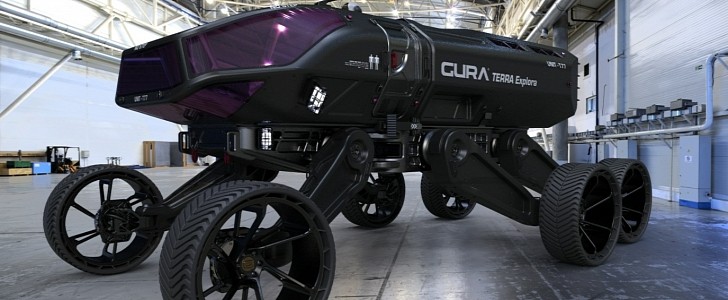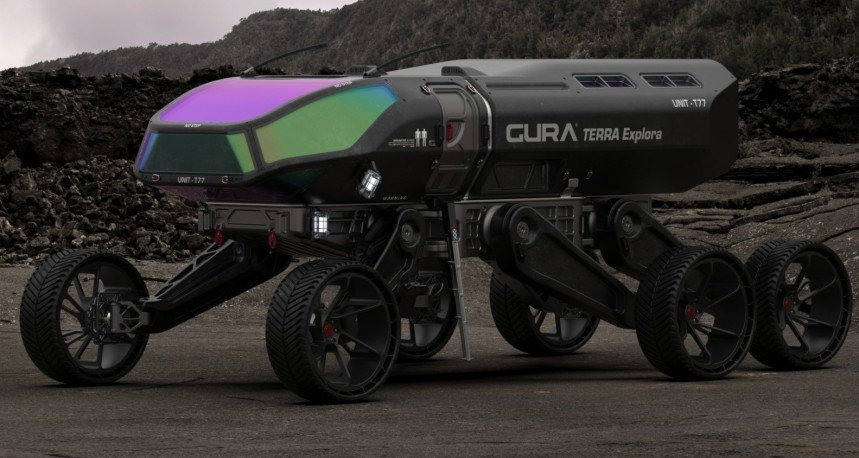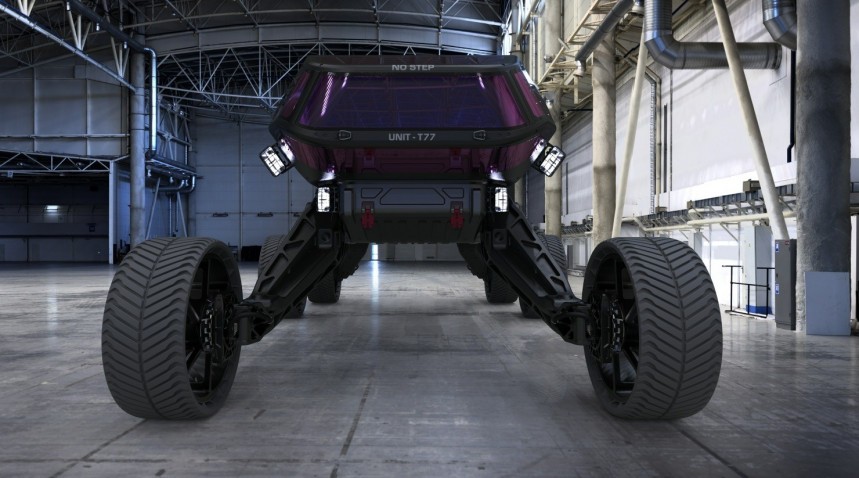There is no doubt that space exploration is booming. With that in mind, some people on this planet are hard at work devising vehicle for a market that hasn’t happened yet but that surely will.
Folks, what you’re looking at is known as the Gura Terra Incognito Space Rover. Why the incognito bit, I'm still trying to figure that out. Doesn’t even matter what you’ll end up calling this vehicle, it’ll still be just as badass. But first, a bit about its creator.
The mind behind this design is Edon Guraziu, founder and owner of a design and consultation firm (GURACORP) operating out of Oosterbeek, Netherlands. In case you need some sort of help with a design project, be it aimed at space, weapons, vehicles, or even robots, this team will offer services from simple remote consultation, for an easy $5,000, to conceptual designs for the automotive industry for a minimum of $150,000. Personally, once you learn what the Gura Terra will be able to do, if it ever makes it into a real design, you too will agree that this team deserves every dollar for their work.
The Terra is meant to be an extraterrestrial transportation and reconnaissance vehicle with a completely self-regulating life support system suitable for a crew of up to six members. The number one focus in mind for the Terra is safety. By strategically compartmentalizing a pressurized hull, the crew claims a calamity survival rate up to 72%. How this is tested, I'm not sure, but I'll play the gullible type and believe it, for now anyway.
How it works, on the other hand, is known. In the eventuality of a hull breach or loss of cabin pressure, automated systems guide the crew to safer chambers within the vehicle.
Up next, technology. In order to traverse off-world planets, and to do it while keeping everyone on board alive, the Terra is equipped with the latest generation of navigations, optics, sensors, and arrays. All this hardware is to be used in tandem with the ASA (Autonomous Self Awareness) software that allows this vehicle to know exactly where it is at all times, but also what is found in the surrounding area.
To move around said areas, the Terra uses an in-house drivetrain named Hexa-Drive. Underneath the body of the vehicle, and built into a sort of chassis, are six individual legs, much like those on a rover. Each of these legs is controlled by a dedicated electro-motor with high torque output that allows this over-sized rover to adapt seamlessly to the terrain encountered under its wheels.
Speaking of wheels, if you look closely, you’ll notice six individual airless tires that have been designed in such a way as to minimize maintenance and eliminate any possibility of punctures or blowouts. These sorts of tires make sense if you’re looking at space exploration. Why? Simple. Gases behave differently at different pressures and temperatures other than the ones experienced on Earth.
Simply put, a mix of oxygen, nitrogen, and some helium are enough to support your car here on Earth, but on Mars, you’ll probably be driving around on flats. Not to mention the amount of pressure exerted on wheel systems due to the force of gravity pulling everything down, or up, I don’t know, I'm no astrologist, or was that astrophysicist?
Finally, the Terra is supposed to offer an easy of maintenance for crew and eventual customers. By creating a design with drop-in structures, this rover is easily maintained in case of any sustained damage. This is true for upgrading components as well; just as easy.
As far as my understanding goes, for the time being, this design is only here to show you what some people are doing for a living, paving the way for safe space exploration. What are you creating?
The mind behind this design is Edon Guraziu, founder and owner of a design and consultation firm (GURACORP) operating out of Oosterbeek, Netherlands. In case you need some sort of help with a design project, be it aimed at space, weapons, vehicles, or even robots, this team will offer services from simple remote consultation, for an easy $5,000, to conceptual designs for the automotive industry for a minimum of $150,000. Personally, once you learn what the Gura Terra will be able to do, if it ever makes it into a real design, you too will agree that this team deserves every dollar for their work.
The Terra is meant to be an extraterrestrial transportation and reconnaissance vehicle with a completely self-regulating life support system suitable for a crew of up to six members. The number one focus in mind for the Terra is safety. By strategically compartmentalizing a pressurized hull, the crew claims a calamity survival rate up to 72%. How this is tested, I'm not sure, but I'll play the gullible type and believe it, for now anyway.
Up next, technology. In order to traverse off-world planets, and to do it while keeping everyone on board alive, the Terra is equipped with the latest generation of navigations, optics, sensors, and arrays. All this hardware is to be used in tandem with the ASA (Autonomous Self Awareness) software that allows this vehicle to know exactly where it is at all times, but also what is found in the surrounding area.
To move around said areas, the Terra uses an in-house drivetrain named Hexa-Drive. Underneath the body of the vehicle, and built into a sort of chassis, are six individual legs, much like those on a rover. Each of these legs is controlled by a dedicated electro-motor with high torque output that allows this over-sized rover to adapt seamlessly to the terrain encountered under its wheels.
Speaking of wheels, if you look closely, you’ll notice six individual airless tires that have been designed in such a way as to minimize maintenance and eliminate any possibility of punctures or blowouts. These sorts of tires make sense if you’re looking at space exploration. Why? Simple. Gases behave differently at different pressures and temperatures other than the ones experienced on Earth.
Finally, the Terra is supposed to offer an easy of maintenance for crew and eventual customers. By creating a design with drop-in structures, this rover is easily maintained in case of any sustained damage. This is true for upgrading components as well; just as easy.
As far as my understanding goes, for the time being, this design is only here to show you what some people are doing for a living, paving the way for safe space exploration. What are you creating?










